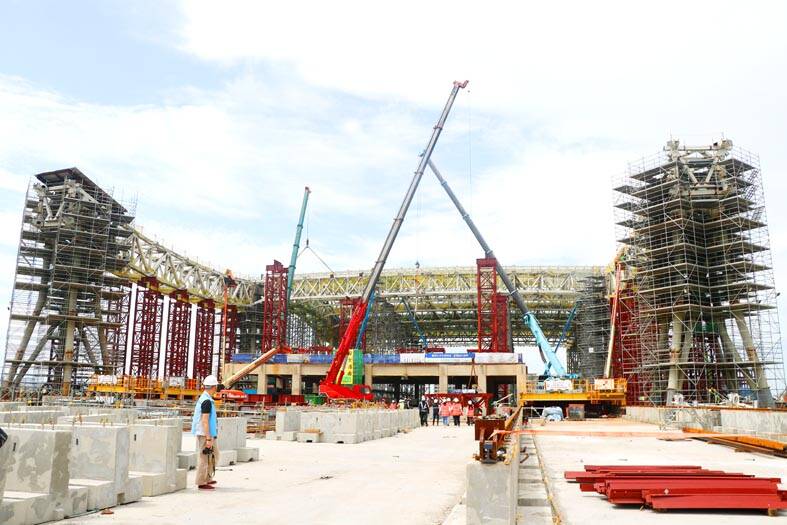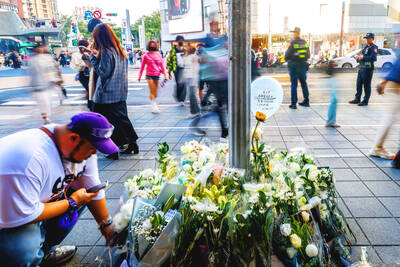The north concourse of Taiwan Taoyuan International Airport’s Terminal 3 is scheduled to begin operations in the middle of next year, Taoyuan International Airport Corp (TIAC) said yesterday.
The Terminal 3 project was launched as the number of air travelers accessing the nation’s largest international airport each year has already exceeded the combined capacity of terminals 1 and 2.
The two existing terminals were designed to be accessed by 37 million air travelers per year. Prior to the COVID-19 pandemic, about 48.36 million accessed the airport in 2019.

Photo: Tsai Yun-jung, Taipei Times
The airport operator yesterday organized a field trip for reporters to see Terminal 3 construction sites.
TIAC chairman Yang Wei-fuu (楊偉甫) told reporters that 26 million air travelers had accessed the airport as of last month, and the number of the air travelers accessing the airport this year could potentially be 44 million to 45 million, which is about 92 to 94 percent of the 2019 level.
Once Terminal 3 is completed, the airport’s passenger service capacity would expand to 82 million travelers per year from 37 million, Yang said.
The company estimated that more than 50 million passengers are to access the airport per year by 2028.
Based on the company’s plan, Terminal 3 would be mainly used for flight services connecting North America and Southeast Asian nations offered by China Airlines, EVA Airways and Starlux Airlines.
As of last month, the nation had welcomed about 3.936 million transit passengers, up from 3.46 million during the same period last year.
About 77 percent of the airport’s transit passengers this year were those traveling between North America and Southeast Asia, TIAC data showed.
Approximately 40 percent of transit travelers flew from the US or Canada to Southeast Asian nations, data showed.
So far, 42.3 percent of the Terminal 3 project — the terminal, aprons, taxiways, substations, an energy center and an office building — has been completed, about 1 percent behind the construction schedule, the company said.
Although the entire Terminal 3 project would not be completed until 2027, the north concourse is scheduled to begin operations in the middle of next year, which could add eight more aircraft parking spaces to the airport, the company said.
The cost of the project is now estimated to be NT$128.37 billion (US$3.97 billion), up from the previous estimate of NT$95.6 billion, due to inflation and other factors, the company said.
The terminal per se costs about NT$44.53 billion. Its rooftop area is about 100,000m2, which is nearly three times larger than the Taipei Dome. The aggregate floor area is about 580,000m2, the company said.
Yang cited the COVID-19 pandemic and the high turnover rate of migrant workers as the two biggest challenges the project has faced, adding that the problem with the migrant workers was addressed by changing human resources agencies.
TIAC sustained substantial financial losses due to the COVID-19 pandemic, turning it from a profitable firm to one in debt.
As of last year, the company had NT$5.4 billion of accumulated financial losses, Yang said.
“We have a very good chance to cover the losses this year due to the return of air travelers. However, we still need to spend about NT$300 billion in the next few years building the third runway and other infrastructure,” he said.

SHIPS, TRAINS AND AUTOMOBILES: The ministry has announced changes to varied transportation industries taking effect soon, with a number of effects for passengers Beginning next month, the post office is canceling signature upon delivery and written inquiry services for international registered small packets in accordance with the new policy of the Universal Postal Union, the Ministry of Transportation and Communications said yesterday. The new policy does not apply to packets that are to be delivered to China, the ministry said. Senders of international registered small packets would receive a NT$10 rebate on postage if the packets are sent from Jan. 1 to March 31, it added. The ministry said that three other policies are also scheduled to take effect next month. International cruise ship operators

HORROR STORIES: One victim recounted not realizing they had been stabbed and seeing people bleeding, while another recalled breaking down in tears after fleeing A man on Friday died after he tried to fight the knife-wielding suspect who went on a stabbing spree near two of Taipei’s busiest metro stations, Taipei Mayor Chiang Wan-an (蔣萬安) said. The 57-year-old man, identified by his family name, Yu (余), encountered the suspect at Exit M7 of Taipei Main Station and immediately tried to stop him, but was fatally wounded and later died, Chiang said, calling the incident “heartbreaking.” Yu’s family would receive at least NT$5 million (US$158,584) in compensation through the Taipei Rapid Transit Corp’s (TRTC) insurance coverage, he said after convening an emergency security response meeting yesterday morning. National

The Forestry and Nature Conservation Agency yesterday launched a gift box to market honey “certified by a Formosan black bear” in appreciation of a beekeeper’s amicable interaction with a honey-thieving bear. Beekeeper Chih Ming-chen (池明鎮) in January inspected his bee farm in Hualien County’s Jhuosi Township (卓溪) and found that more than 20 beehives had been destroyed and many hives were eaten, with bear droppings and paw prints near the destroyed hives, the agency said. Chih returned to the farm to move the remaining beehives away that evening when he encountered a Formosan black bear only 20m away, the agency said. The bear

PLANNED: The suspect visited the crime scene before the killings, seeking information on how to access the roof, and had extensively researched a 2014 stabbing incident The suspect in a stabbing attack that killed three people and injured 11 in Taipei on Friday had planned the assault and set fires at other locations earlier in the day, law enforcement officials said yesterday. National Police Agency (NPA) Director-General Chang Jung-hsin (張榮興) said the suspect, a 27-year-old man named Chang Wen (張文), began the attacks at 3:40pm, first setting off smoke bombs on a road, damaging cars and motorbikes. Earlier, Chang Wen set fire to a rental room where he was staying on Gongyuan Road in Zhongzheng District (中正), Chang Jung-hsin said. The suspect later threw smoke grenades near two exits